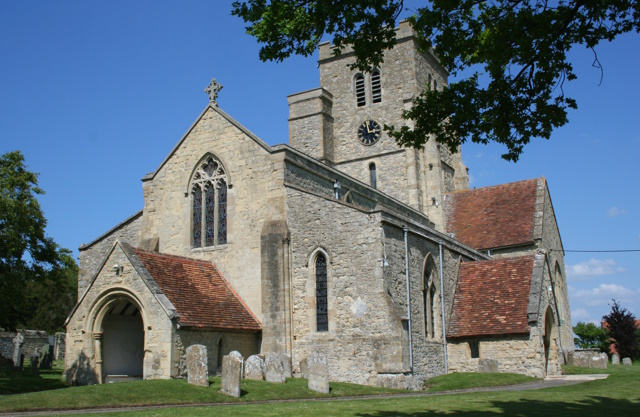


























All Saints Church, Cuddesdon
All Saints Church in Cuddesdon is cruciform, with chancel, nave, side aisles, transepts, and central tower. The original church must have been built before 1117, when Abbot Faritius, who gave it to Abingdon Abbey, died. It was rebuilt on a cruciform plan about 1180. There is good Romanesque carving on the west and south doorways, with lozenge moulding and tooth ornament. Of the same period are the tower arches, the west buttresses, the walls of the north transept (with one small roundheaded window), the stair turret at the north-west angle of the tower, and the opening to the rood loft. The nave aisles were added in the mid-13th century, the north aisle being rougher work than the south, and three small lancet windows on the south side belong to this period. In the 14th century most of the aisle windows were replaced, the walls were raised, and the south porch added. The clerestory, the west windows, and the window in the north wall on the north transept were added just before the chancel was rebuilt in the late 14th or early 15th century, perhaps in 1375–6, when the accounts of Abingdon Abbey include a payment of 50s. for Wheatley stone super cancellam de cuddesdon. Traces of painting, possibly medieval, remain on the tower piers. By 1520 the chancel was in need of repair, and in 1630, in spite of episcopal patronage, the body of the church and the seats were noted as in great decay. Bartholomew Day, a local craftsman, undertook repairs; and the upper part of the tower, the south transept, the oak roof of the nave, and other woodwork are of this date. During the 18th century many minor repairs and improvements were carried out. A new clock was made (1776), and Mr. Bush of Oxford supplied a new weather-vane in 1789. In 1842 major restoration work began under G. E. Street, the diocesan architect. The groining of the crossing was restored, the west gallery and the plaster ceiling of the chancel removed, and the roof repaired. The 'four clumsy windows' in the chancel were replaced; stalls, a stone pulpit, reredos, and new glass in the choir were added. A new pulpit of oak was installed in 1896, executed by C. E. Kempe and carved by Miss Stubbs, the bishop's daughter. Hardman made the west window (Christ in Majesty) from Street's design. Electric light was installed in 1895–6, and the high altar was reconstructed in 1931 by H. S. Rogers, architect, of Oxford. Chancel screen, gates, and nave altar commemorate Vice-Principal J. Russell (d. 1937). Recent stained glass displays episcopal coats of arms, and there are memorial windows to Bishop Mackarness (d. 1889), Bishop Stubbs (d. 1901), and Joseph Moore, Vicar of Buckland (Berks.) (d. 1876). The inventory of 1553 shows a rich variety of vestments which did not long survive. Perhaps there was also a minor possession of interest, for in 1529 William Bayley, who left 'his beste goode' as mortuary, following the custom of the parish, bequeathed 20d. 'to buy a pursse to cary the blessed sacrament to visitacions within the parish'. The earliest plate dates from 1771. There are six bells mostly dating from the 17th and 18th centuries, and a sanctus. The second, third, and fourth are by Henry Knight of Reading. A former fifth was dated 1677, and a former tenor 1709. The surviving registers start in 1541, and included Wheatley until its separation from the parish in the 19th century. From 1628 Wheatley christenings were entered separately. Historical information about All Saints Church is provided by 'Parishes: Cuddesdon', in A History of the County of Oxford: Volume 5, Bullingdon Hundred, ed. Mary D Lobel (London, 1957), pp. 96-116. British History Online http://www.british-history.ac.uk/vch/oxon/vol5/pp96-116 [accessed 16 March 2023]. All Saints Church is a Grade I listed building. For more information about the listing see Church of All Saints, Cuddesdon and Denton - 1047709 | Historic England. For more information about All Saints Church see Parishes: Cuddesdon | British History Online (british-history.ac.uk). |

